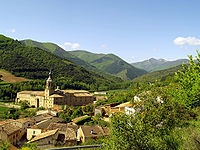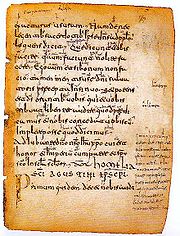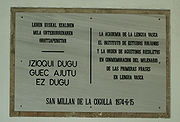
Glosas Emilianenses
Encyclopedia

Gloss
A gloss is a brief notation of the meaning of a word or wording in a text. It may be in the language of the text, or in the reader's language if that is different....
es written in a Latin
Latin
Latin is an Italic language originally spoken in Latium and Ancient Rome. It, along with most European languages, is a descendant of the ancient Proto-Indo-European language. Although it is considered a dead language, a number of scholars and members of the Christian clergy speak it fluently, and...
codex
Codex
A codex is a book in the format used for modern books, with multiple quires or gatherings typically bound together and given a cover.Developed by the Romans from wooden writing tablets, its gradual replacement...
. These marginalia
Marginalia
Marginalia are scribbles, comments, and illuminations in the margins of a book.- Biblical manuscripts :Biblical manuscripts have liturgical notes at the margin, for liturgical use. Numbers of texts' divisions are given at the margin...
are important as early examples of writing in Basque
Basque language
Basque is the ancestral language of the Basque people, who inhabit the Basque Country, a region spanning an area in northeastern Spain and southwestern France. It is spoken by 25.7% of Basques in all territories...
and a form of Spanish
Spanish language
Spanish , also known as Castilian , is a Romance language in the Ibero-Romance group that evolved from several languages and dialects in central-northern Iberia around the 9th century and gradually spread with the expansion of the Kingdom of Castile into central and southern Iberia during the...
. The anonymous author is assumed to have been a monk at the monastery now known as Suso ("the upper one"), one of the twin monasteries of San Millán de la Cogolla (now in La Rioja, then in the Kingdom of Navarre
Kingdom of Navarre
The Kingdom of Navarre , originally the Kingdom of Pamplona, was a European kingdom which occupied lands on either side of the Pyrenees alongside the Atlantic Ocean....
). He wrote about a thousand years ago in three languages:
- A simplified version of LatinLatinLatin is an Italic language originally spoken in Latium and Ancient Rome. It, along with most European languages, is a descendant of the ancient Proto-Indo-European language. Although it is considered a dead language, a number of scholars and members of the Christian clergy speak it fluently, and...
- The medieval form of a Hispanic RomanceIberian Romance languagesThe Iberian Romance languages or Ibero-Romance languages are the Romance languages that developed on the Iberian Peninsula, an area consisting primarily of Spain, Portugal, and Andorra....
language (traditionally regarded as Castilian or Old Spanish, but most probably Navarro-AragoneseNavarro-AragoneseNavarro-Aragonese was a Romance language spoken south of the middle Pyrenees and in part of the Ebro River basin in the Middle Ages. The language extended over the County of Aragón, Sobrarbe, Ribagorza, the southern plains of Navarre on both banks of the Ebro including La Rioja and the eastern...
or a related dialect); - Medieval Basque
The latter two would have been the vernacular
Vernacular
A vernacular is the native language or native dialect of a specific population, as opposed to a language of wider communication that is not native to the population, such as a national language or lingua franca.- Etymology :The term is not a recent one...
languages in the region surrounding the monastery, although there is a possibility that the author of the glosses was an incomer to the area.
Location of the glosses
The codex is known as Aemilianensis 60 (Aemilianus is Latin for Emilian, "Millán" or "Emiliano" in modern SpanishSpanish language
Spanish , also known as Castilian , is a Romance language in the Ibero-Romance group that evolved from several languages and dialects in central-northern Iberia around the 9th century and gradually spread with the expansion of the Kingdom of Castile into central and southern Iberia during the...
) and was preserved in the monastery library at Yuso (the lower re-foundation of the monastery). Its significance was recognised in the early twentieth century when it was brought to the attention of the philologist Ramón Menéndez Pidal
Ramón Menéndez Pidal
Ramón Menéndez Pidal was a Spanish philologist and historian. He worked extensively on the history of the Spanish language and Spanish folklore and folk poetry. One of his main topics was the history and legend of The Cid....
. The manuscript's current location is the Real Academia de la Historia
Real Academia de la Historia
Real Academia de la Historia is a Spanish institution based in Madrid that studies history "ancient and modern, political, civil, ecclesiastical, military, scientific, of letters and arts, that is to say, the different branches of life, of civilisation, and of the culture of the Spanish...
in Madrid
Madrid
Madrid is the capital and largest city of Spain. The population of the city is roughly 3.3 million and the entire population of the Madrid metropolitan area is calculated to be 6.271 million. It is the third largest city in the European Union, after London and Berlin, and its metropolitan...
.
Romance glosses

Kharja
The kharja , also known as jarcha in Spanish, is the final refrain of a muwashshah, a lyric genre of Al-Andalus written in Classical Arabic or Hebrew....
s, are proved to be in a different medieval Romance, Mozarabic
Mozarabic language
Mozarabic was a continuum of closely related Romance dialects spoken in Muslim-dominated areas of the Iberian Peninsula during the early stages of the Romance languages' development in Iberia. Mozarabic descends from Late Latin and early Romance dialects spoken in the Iberian Peninsula from the 5th...
, which happens to be classified along with Aragonese in a Pyrenean-Mozarabic group. Some scholars have proposed that it is anachronistic to classify such varieties of Ibero-Romance according to dialectal labels based on geographical particularism before the thirteenth century, leaving the Glosas to be understood as "in an unspecialized informal register of Ibero-Romance.".
However the Romance language of the glosses should be classified, San Millán de la Cogolla's reputation as the "birthplace of the Spanish language" was important in its designation as a World Heritage Site
World Heritage Site
A UNESCO World Heritage Site is a place that is listed by the UNESCO as of special cultural or physical significance...
("cultural" type) in 1997.
Text and translation
The longest gloss appears on page 72 of the manuscripts. The Spanish philologist Dámaso AlonsoDámaso Alonso
Dámaso Alonso y Fernández de las Redondas was a Spanish poet, philologist and literary critic. Though a member of the Generation of '27, his best-known work dates from the 1940s onwards. -Early life and education:...
called this little prayer the "first cry of the Spanish language" (in Spanish: "el primer vagido de la lengua española").
(Listen in restored pronunciation)
Comparative table
Comparison of some words used in the glosses, along with their current corresponding forms in Aragonese, Spanish and Latin language. English translation provided.| Glosses | Aragonese Aragonese language Aragonese is a Romance language now spoken in a number of local varieties by between 10,000 and 30,000 people over the valleys of the Aragón River, Sobrarbe and Ribagorza in Aragon, Spain... | Spanish Spanish language Spanish , also known as Castilian , is a Romance language in the Ibero-Romance group that evolved from several languages and dialects in central-northern Iberia around the 9th century and gradually spread with the expansion of the Kingdom of Castile into central and southern Iberia during the... | Latin | Translation to English English language English is a West Germanic language that arose in the Anglo-Saxon kingdoms of England and spread into what was to become south-east Scotland under the influence of the Anglian medieval kingdom of Northumbria... |
|---|---|---|---|---|
| de los (delo) | de los, d’os | de los | < DE ILLOS | of the (masculine, plural article) |
| ela | a, l’ | la | < ILLA | the (feminine, singular article) |
| ena, enos | en a, en os | en la, en los | < IN ILLAM, IN ILLOS | in the (feminine, singular and masculine, plural articles) |
| fere | fer | hacer | < FACERE | to make |
| siéculo | sieglo | (sieglo >) siglo | < SAECULU | century |
| yet | ye | es | < EST | is (3rd person, singular, verb "to be") |
Basque Glosses

Only two of the glosses in Aemilianensis 60 (of a total of about one thousand) are actually in Basque. These short texts (only 6 words in total) can be seen on the 1974 plaque. However, it has been suggested that some of the Romance glosses reflect the influence of the Basque language, the implication being that their author was a fluent Basque-speaker.
See also
- Spanish languageSpanish languageSpanish , also known as Castilian , is a Romance language in the Ibero-Romance group that evolved from several languages and dialects in central-northern Iberia around the 9th century and gradually spread with the expansion of the Kingdom of Castile into central and southern Iberia during the...
- Monasteries of San Millán de la CogollaMonasteries of San Millán de la CogollaThe monasteries of San Millán de Suso and San Millán de Yuso are two monasteries situated in the village of San Millán de la Cogolla, La Rioja, Spain. They have been designated a World Heritage Site by UNESCO....
- Navarro-Aragonese dialectNavarro-AragoneseNavarro-Aragonese was a Romance language spoken south of the middle Pyrenees and in part of the Ebro River basin in the Middle Ages. The language extended over the County of Aragón, Sobrarbe, Ribagorza, the southern plains of Navarre on both banks of the Ebro including La Rioja and the eastern...
- Early Spanish Literature and the Middle AgesSpanish literatureSpanish literature generally refers to literature written in the Spanish language within the territory that presently constitutes the state of Spain...
- Basque LanguageBasque languageBasque is the ancestral language of the Basque people, who inhabit the Basque Country, a region spanning an area in northeastern Spain and southwestern France. It is spoken by 25.7% of Basques in all territories...
- Wikisource: Glosas Emilianenses

